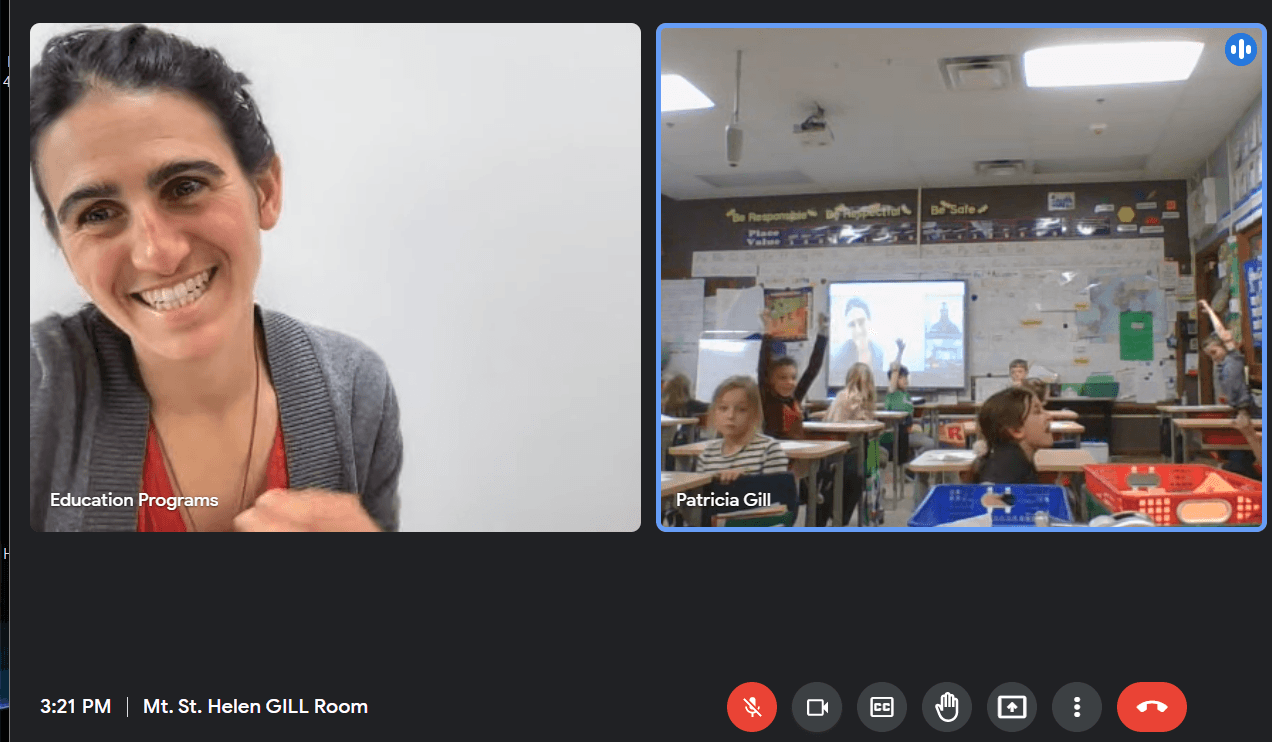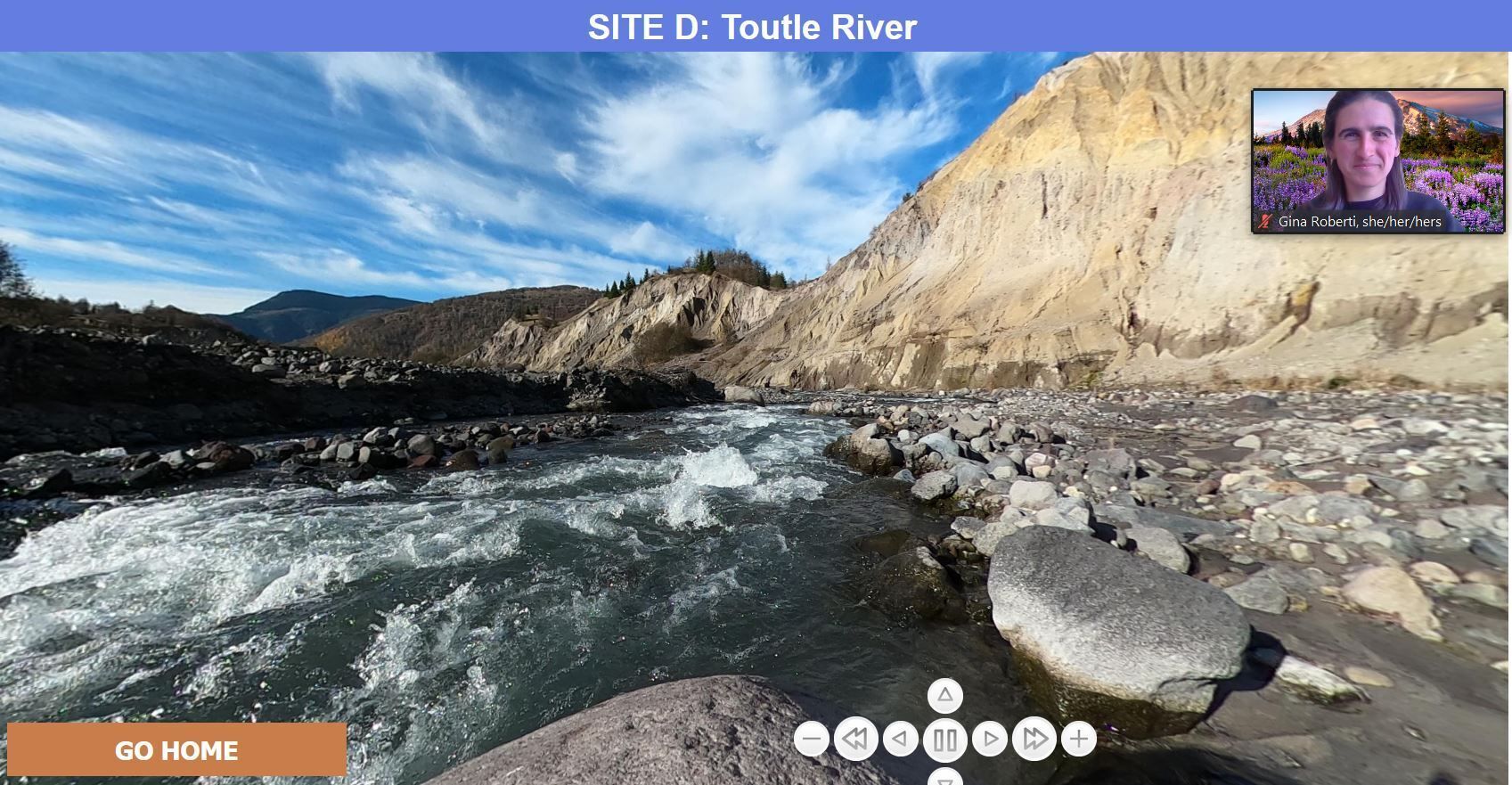By Sonja Melander, Science Education Manager

The time was Fall 2020. We had completed our Volcano Tuesdays video series, we had nearly completed the Sediment on the Move unit, and we were facing another year of uncertainty. Behind the scenes at Mount St. Helens Institute, fall is the time of year that we typically begin looking ahead to and planning for the next spring/summer/fall in-person field trip season. So the question was: what next? Would we be able to offer in-person field trips in 2021? The answer was that nobody knew, nobody could know. Still, we planned for ways that we could offer in-person programming in 2021. It would be much more limited in scope and scale than in “normal times”, but some is better than none. So it was with cautious optimism that we kept planning for a return of in-person programming for 2021. But with a healthy dose of realism we knew that whatever level of in-person programming we could offer would only serve a small set of students. So, how to channel our energy into something that could support all these learners that couldn’t physically come to the mountain? How could we bring Mount St. Helens Institute into the classroom or into the home?
Months before, in the early days of the COVID-19 pandemic, we conducted a needs survey for teachers. Among the questions, we asked was what types of resources they would want to support their learners in their remote learning environment. “Virtual field trips” was the #1 response. We listened. Treading new water, we wondered: what are virtual field trips? What was clear about virtual field trips is that there was no clear understanding of what virtual field trips are. This is true even today, though the reasons are different. Today, a plethora of virtual field trip possibilities exist. Sometimes a virtual field trip might be a skilled interpreter with props and a camera video-conferencing with a class. Or perhaps it is a website with a series of links for students to view photos and read about a place. Our virtual field trips grew from contemplation over these months about what OUR field trips are and how we can (to whatever extent) recreate that in the digital realm.
At our field trips, students spend a lot of time outside. Students make observations about the shape of the land to think about the forces of nature that have shaped the land. Students make observations of the life at Mount St. Helens, in places where the May 18, 1980 lateral blast scraped and scoured the land and in places where the landslide buried the old landscape in rock hundreds of feet deep, to think about the interactions that shaped the renewal of life at Mount St. Helens post-eruption. Making observations is at the heart of what we do during our education programs. Some students may focus on large physical features. Some students might notice a physically-small but conceptually-illuminating feature, such as the particularly angular rocks on the ground in the blast zone. Students observe these things and our educators facilitate a discussion to share them and to think deeper about them. Our approach incorporates research-backed practices for outdoor science programs. In part, these practices are what field trips mean to us.
How then do we create a tool where students can explore and notice things? Over the months we spent mulling over what it means to be a “virtual field trip”, we researched tools and platforms to explore options and possibilities. In particular, I was drawn to the idea of using “360-degree virtual tour” software, which is used most commonly for online viewing of real estate. Why? Like other humans, I have been shaped by my experiences. Growing up, I played several point-and-click adventure games on CD-ROMS. Games like “SPQR: The Empire’s Darkest Hour” and “Titanic: Adventure out of Time” immersed me in places that I otherwise could not have traveled to. Clicking to walk around the forum of ancient Rome and the halls, rooms, deck, and engine room of the Titanic, I developed a familiarity with the geography of these places. When I watch Titanic (1997), I know when Jack and Rose are on A deck or B deck or when they are on the port or starboard side of the ship. Exploring these places via these point-and-click games helped me develop a sense of place for these otherwise unexplorable places. With this memory and my own awareness of its long-lasting impact, I realized that this (using the virtual tour software) was how we could bring Mount St. Helens into classrooms and into homes.
Back to Fall 2020. Virtual tours such as these require 360-degree photographs or media. Many of the trails and views at Mount St. Helens are at elevations of 3,000 feet above sea level or higher and there, fall quickly turns to winter. If we were to make this happen, we needed to act quickly. We did not have the software nor the supplies for this project. I am thankful for our partners at the U.S. Forest Service/Mount St. Helens National Volcanic Monument. We shared this idea with them and they supported us in acquiring access to the required software and tools to make this happen!
Now was the time for action. We needed footage of sites at Mount St. Helens. I went out a few times and took a few photos/video, but there was only so much I could accomplish. I made mistakes along the way but despite this, we had enough footage to begin development. I am so grateful for my fellow staff and volunteers, who gathered footage from the climbing route, the Pumice Plain, the Hummocks Trail, and more! In December we tested out the virtual field trip with a close network of teachers and partners. The result? It was a technological mess and I fretted over failure. But seeing this first draft in action and its weaknesses was a window of insight into improvement. So we made version 2.
Within a few weeks, things accelerated! We made changes to our virtual platform, opened up registration, reached out to schools in and outside of our regular network. We let them know that financial assistance was available for these virtual field trips (by the way, it still is). We designed a full learning package, including a pre-made but customizable presentation that teachers can use to teach about the events of the 1980 eruption, a live session with a MSHI educator (i.e. myself or most commonly, Gina Roberti, Science Education Coordinator, who is part of the “we” and “us” I have written so many times in this article thus far), and additional lessons and resources.
Late January saw the start of our live sessions! Live sessions included activities like drawing/sharing drawings, stepping away from the computer to stretch, shake and wiggle using various forms of our Mountain Moves activity, and of course, exploring the 360-degree sites, sharing observations and curiosities. In 2021, we reached 2,934 students through our virtual field trips. 2021 also saw the return of in-person programming, but our own hybrid approach meant that there were thousands more students making a connection to Mount St. Helens that otherwise would not have been able to!
A growth mindset is at the heart of what we do at the Mount St. Helens Institute. Always on the lookout for improvement, we began to plan what our next steps would be to further improve these virtual field trips. In 2021, Dylan Klinestecker joined our team as a Seasonal Educator, leading the in-person programs at the Science and Learning Center and the nearby vicinity. Because the return to in-person programming was slow, Dylan had time for creative work, and he produced this video telling the story of the May 18, 1980 eruption. This video is now an important part of our virtual field trips. This video sets the scene for our virtual field trips and helps students to develop initial ideas about the phenomena at work on the Mount St. Helens landscape.
In 2021, we gathered new and better footage for our virtual field trips.. In just a few clicks, students can go from being high up on the crater rim viewing the glacier, lava dome, and layers of rock exposed by the 1980 eruption to down on Pumice Plain, viewing cliffsides of rock layers built up by the pyroclastic flows of the 1980 eruption. We gathered footage of vibrant wildflowers, wildflowers like lupine are so important to understanding the story of how life renewed at Mount St. Helens post-eruption.
In the virtual field trip, students first make their own observations of the landscape, as a geologist or ecologist would, to gather evidence and support ideas about what happened to make it look the way it does. In a later part of the virtual field trip, students visit the sites again to explore other evidence. This evidence is in the form of “clues” that students find. Inspired in part by “Blue’s Clues,” in part by the aforementioned point-and-click adventure games, we developed a set of “clues” for each site. For the most part, these clues are videos, photos, and other media produced by our partners and other organizations conducting education and outreach of volcanic landscapes. They include videos produced by the US Forest Service, the US Geological Survey, Volfilm, and other researchers. They include photos from our staff, partners, and others. We used some really neat free tools from Knightlab.
While the 360-degree photos and videos provided a high degree of realism and immersion, we wanted to do better. Sound artist Patricia Wolf volunteered to help us with that. Human activity was quiet at Mount St Helens in 2021, but the sounds of nature were as vivacious as ever. At Mount St. Helens, Patricia recorded the sounds of bird song, chorus frogs, moving water, and more. Now, students anywhere can experience not just the sights of Mount St. Helens, but its sounds too.
The NatureWatch, Interpretation and Conservation Education (NICE) database is a Forest Service database of outreach and education activities for which the US Forest Service provided funds and/or staff time. Because this work was supported by the US Forest Service in so many ways, the collaboration is recorded in this database. Now, this project has been recognized at the federal level. It is with great honor that this work (in addition to our Sediment on the Move project) was recognized in the NICE Golden Pinecone Awards Ceremony. It is with an even greater amount of gratitude and camaraderie that we recognize and appreciate the role of our partners at the US Forest Service in helping us make this a reality.
What’s next? We have made changes, not yet released, with sounds, better footage, and other improvements to the user experience. We are working through identifying and fixing some bugs and other errors in this platform, but all are welcome to take a peek!
We are also excited to announce an upcoming change in how our virtual field trips are accessed. Beginning next school year, our virtual field trip platform will be freely available to all. Groups may still choose to sign up for a live session with one of our education team (and financial assistance will still be available for that), but now students anywhere will be able to freely explore Mount St. Helens, virtually. While we keep the hearth warm for in-person field trips, we also keep the hearth warm for those exploring virtually. We advance understanding and stewardship of the Earth through science, education, and exploration of volcanic landscapes - in person AND virtually.
